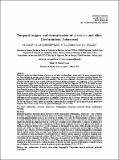Por favor, use este identificador para citar o enlazar a este item:
http://hdl.handle.net/10261/50017COMPARTIR / EXPORTAR:
 SHARE SHARE
 CORE
BASE CORE
BASE
|
|
| Visualizar otros formatos: MARC | Dublin Core | RDF | ORE | MODS | METS | DIDL | DATACITE | |

| Título: | Temporal origins and diversification of Artemisia and allies (Anthemideae, Asteraceae). |
Otros títulos: | Evolución temporal y diversificación en Artemisia y géneros relacionados (Anthemideae, Asteraceae). | Autor: | Sanz, María CSIC; Schneeweiss, G. M.; Vilatersana, Roser CSIC ORCID ; Vallès, Joan CSIC ORCID | Palabras clave: | Anthemideae Artemisia Artemisiinae Biogeography Compositae Molecular dating Morphological evolution Biogeografía Datación molecular Evolución morfológica |
Fecha de publicación: | 2011 | Editor: | Consejo Superior de Investigaciones Científicas (España) | Citación: | Collectanea Botanica 30: 7-15 (2009) | Resumen: | [EN] To assess temporal origins
and diversification of lineages within subtribe Artemisiinae and Artemisia group a penalized likelihood analysis was
applied on nrDNA ITS and ETS of 63 representatives. The tree was calibrated at the stem node of the Kaschgaria/
Artemisia lineage with the most reliable early Artemisia fossil pollen record from Late Oligocene (23 Ma). The results
from this study suggest that the origin of the subtribe goes back to the Late Oligocene (24.6 ± 2.6 Ma) whilst the onset
of differentiation of the genus Artemisia and most closely related genera is dated to the Early Miocene (19.8 ± 2.3 Ma).
Divergence ages for lineages within the Artemisia group are often between the Early and Middle Miocene, whereas
their radiations mostly occurred in the Late Miocene and Pliocene. The temporal context was also used to examine biogeographic
and morphological (capitula and pollen type) evolution. Within the Artemisia group all lineages except the
North American endemic have colonized the Mediterranean Basin at different epochs from Asian ancestors. Our analyses
suggest the divergence of the North American endemic group from Asian ancestors (10.8 ± 1.5 Ma) in the Late Miocene.
Homogamous-discoid capitula, characteristic of subgenera Seriphidium and Tridentatae, evolved not only in different
geographic regions, but also at different times (2.0 ± 0.8 Ma and 7.9 ± 0.9 Ma respectively) within the Artemisia group.
The loss of fertility of central flowers of disciform capitula should be considered as an ancient event in the genus since
subgenus Dracunculus is one of the first groups that diverged (17.6 ± 2.1 Ma). [ES] Con el objetivo de estimar el tiempo de diversificación de los linajes de la subtribu Artemisiinae y el grupo Artemisia se aplicó un análisis de verosimilitud penalizado en base a las secuencias de ADNrn, ITS y ETS, de 63 representantes. El árbol se calibró en el nodo del linaje de Kaschgaria/Artemisia con el polen fósil de Artemisia que se consideró más fiablemente datado, siendo esta datación del Oligoceno Superior (23 Ma). Los resultados de este estudio datan el origen de la subtribu en el Oligoceno Superior (24,6 ± 2,6 Ma), mientras que la diferenciación del género Artemisia y los géneros relacionados es datada en el Mioceno Inferior (19,8 ± 2,3 Ma). El tiempo de divergencia de los linajes dentro del grupo Artemisia está situado entre el Mioceno Inferior y el Medio, mientras que la mayoría de sus radiaciones tuvieron lugar en el Mioceno Superior y en el Plioceno. El contexto temporal también se usó para examinar la evolución biogeográfica y morfológica (tipo de capítulo y polen). Todos los linajes dentro del grupo de Artemisia, excepto el complejo endémico norteamericano, han colonizado la cuenca mediterránea en diferentes épocas. Nuestros análisis sugieren la divergencia del grupo endémico norteamericano de antepasados asiáticos (10,8 ± 1,5 Ma) en el Mioceno Superior. El capítulo homógamo-discoide, característico de los subgéneros Seriphidium y Tridentatae, evolucionó no sólo en diferentes regiones geográficas, sino también en distintas épocas (2,0 ± 0,8 Ma y 7,9 ± 0,9 Ma respectivamente) dentro del grupo Artemisia. La pérdida de fertilidad de las flores centrales del capítulo disciforme se debería considerar como un evento antiguo en el género, puesto que el subgénero Dracunculus es uno de los primeros grupos que divergió (17,6 ± 2,1 Ma). |
Descripción: | 9p., Diagramas. | Versión del editor: | http://dx.doi.org/10.3989/collectbot.2011.v30.001 | URI: | http://hdl.handle.net/10261/50017 | DOI: | 10.3989/collectbot.2011.v30.001 | ISSN: | 0010-0730 |
| Aparece en las colecciones: | (IBB) Artículos |
Ficheros en este ítem:
| Fichero | Descripción | Tamaño | Formato | |
|---|---|---|---|---|
| Sanz_Artemisia.pdf | 313,16 kB | Adobe PDF |  Visualizar/Abrir |
CORE Recommender
Page view(s)
355
checked on 05-may-2024
Download(s)
496
checked on 05-may-2024
Google ScholarTM
Check
Altmetric
Altmetric
NOTA: Los ítems de Digital.CSIC están protegidos por copyright, con todos los derechos reservados, a menos que se indique lo contrario.
